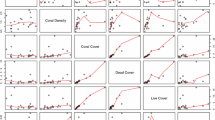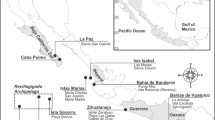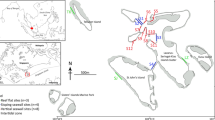Abstract
Sponges and corals are well-known competitors for space on coral reefs. Only a few documented observations are known of sponge-coral interactions in which the latter dominate the former. In the Caribbean, reef-dwelling sponges are generally abundant and have a reputation of being aggressive competitors for space. The present study is exceptional, because it reports on corals overgrowing sponges.
Similar content being viewed by others
Avoid common mistakes on your manuscript.
Within Caribbean coral reef ecosystems, interactions between corals and sponges are well documented, usually with sponges outcompeting corals in direct competition for growth space (Aerts and Van Soest 1997). Some of these sponges are able to produce toxic compounds that may harm and kill scleractinian corals, as demonstrated in interactions between the liver sponge Plakortis halichondrioides (Wilson, 1902) and the lettuce coral Agaricia lamarcki (Milne Edwards and Haime, 1851) (Porter and Targett 1988). Other Caribbean sponges may harm corals by overgrowing them (Loh et al. 2015) or by excavating their skeleton (López-Victoria et al. 2006). Documented examples of sponges becoming partly or completely submissive to corals are exceptional. These are known, for instance, from the Indo-Pacific, involving fast-growing encrusting parts of foliaceous Montipora corals (Elliott et al. 2015) and free-living corals that have dropped and settled on phototrophic sponges (Hoeksema et al. 2014).
During a marine biodiversity survey at St. Eustatius (Lesser Antilles) in June 2015, a colony of Agaricia agaricites (Linnaeus, 1758) was found at 19 m depth overgrowing a brown tube sponge, Agelas conifera (Schmidt, 1870) (Fig. 1a). The sponge showed signs of tissue damage and settlement of red filamentous algae (Fig. 1b). This observation was unexpected, since A. conifera is regarded as a chemically defended sponge which is able to deter fish predation, inhibit growth of other sponges, and prevent fouling organisms from colonizing it (Assmann et al. 2004). This interaction was observed only once during the whole expedition (40 survey sites), whereas both species were found to be co-occurring at 21 sites. In addition, a sunray lettuce coral, Helioseris cucullata (Ellis and Solander, 1786), of the same family (Agariciidae) was found to overgrow an A. conifera tube sponge, with both species reported as co-occurring at 11 sites (Fig. 1c).
The ability of agariciid corals to overgrow chemically defended sponges is worth pursuing. Additional field studies in other Caribbean reefs are needed to confirm whether such interactions are more common than presently assumed.
References
Aerts LAM, van Soest RWM (1997) Quantification of sponge/coral interactions in a physically stressed reef community, NE Colombia. Mar Ecol Prog Ser 148:125–134
Assmann M, Lichte E, Köck M (2004) Multiple defensive roles for Bromopyrrole alkaloids from Caribbean Agelas sponges. Boll Mus 1st Biol Univ Genova 68:187–193
Elliott J, Patterson M, Vitry E, Summers N, Miternique C (2015) Morphological plasticity allows coral to actively overgrow the aggressive sponge Terpios hoshinota (Mauritius, Southwestern Indian Ocean). Mar Biodiv. doi:10.1007/s12526-015-0370-4
Hoeksema BW, Dekker F, de Voogd NJ (2014) Free-living mushroom corals strike back by overtopping a coral-killing sponge. Mar Biodiv 44:3–4
Loh TL, McMurray SE, Henkel TP, Vicente J, Pawlik JR (2015) Indirect effects of overfishing on Caribbean reefs: sponges overgrow reef-building corals. Peer J 3, e901
López-Victoria M, Zea S, Weil E (2006) Competition for space between encrusting excavating Caribbean sponges and other coral reef organisms. Mar Ecol Prog Ser 312:113–121
Porter JW, Targett NM (1988) Allelochemical Interactions between sponges and corals. Biol Bull 175:230–239
Acknowledgments
Fieldwork participation of the first author was funded through a Martin Fellowship from Naturalis Biodiversity Center. Logistic support was provided by St. Eustatius Marine Parks (STENAPA), Caribbean Netherlands Science Institute (CNSI) and Scubaqua Dive Center. We are grateful to three anonymous reviewers for their constructive comments.
Author information
Authors and Affiliations
Corresponding author
Additional information
Communicated by R. Vonk
Rights and permissions
Open Access This article is distributed under the terms of the Creative Commons Attribution 4.0 International License (http://creativecommons.org/licenses/by/4.0/), which permits unrestricted use, distribution, and reproduction in any medium, provided you give appropriate credit to the original author(s) and the source, provide a link to the Creative Commons license, and indicate if changes were made.
About this article
Cite this article
García-Hernández, J.E., van Moorsel, G.W.N.M. & Hoeksema, B.W. Lettuce corals overgrowing tube sponges at St. Eustatius, Dutch Caribbean. Mar Biodiv 47, 55–56 (2017). https://doi.org/10.1007/s12526-016-0467-4
Received:
Revised:
Accepted:
Published:
Issue Date:
DOI: https://doi.org/10.1007/s12526-016-0467-4





